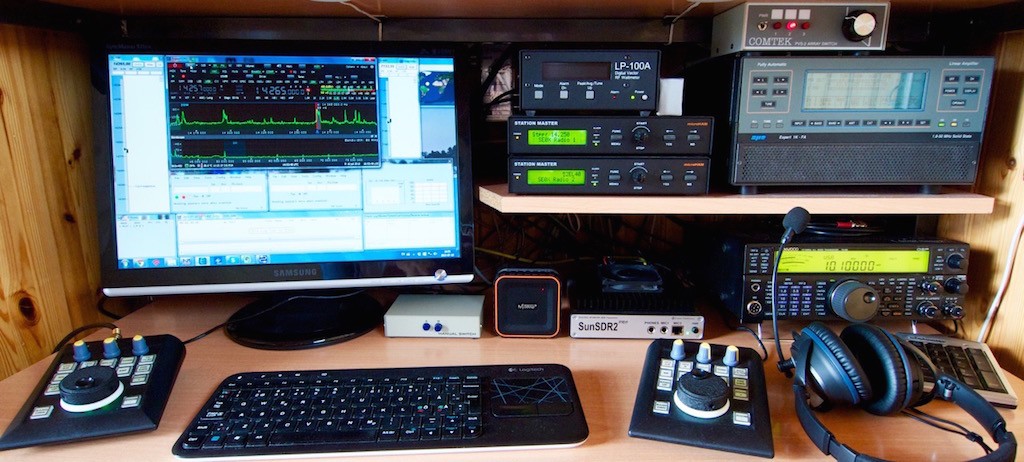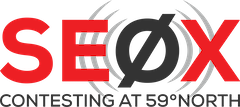Contesting with SDR transceivers
 Earlier this month I was logging more than one thousand contacts in the IARU HF contest using an SDR transceiver. In this blog post I will share my experiences of this modern approach to contesting.
Earlier this month I was logging more than one thousand contacts in the IARU HF contest using an SDR transceiver. In this blog post I will share my experiences of this modern approach to contesting.
If you look for the review of the IARU contest effort itself and the results, look here.
The first thing you notice in the photo of the operating position at SEØX are the two hardware controllers for the SDR transceiver. The transceiver itself, the SunSDR2 PRO is not competing for desk space nor attention, it is the small box to the left of the TS-590 backup transceiver. It could as well be hidden out of sight or even moved to a separate transmitter room away from the shack and operated remotely over the LAN, local area network.
Now, when looking at the photo, think away of the radio, amplifier, microHAM boxes and the backup transceiver. Now you can vision the operating position of a future contest station built around the SDR technology. A clean desk with a big screen, keyboard and hardware controllers for the radios. The only visible cables would be USB cables for keyboard and controllers. Tomorrow’s operators would most likely opt for touch screens and throw out the hardware controllers too.
This is not my first contest with an SDR. Earlier this year I operated CQ-160 SSB with a SunSDR2, the predecessor to the SunSDR2 PRO. The turnout was so good so I decided to continue to investigate this route.
In preparations for the IARU HF contest I spent quite some time to rewire the station and set up the software to make the SunSDR2 PRO play along with N1MM and the automation in place at SEØX. It sounds like a simple task, but some things had to be done different from the current setup. With an SDR transceiver you can, and most of the time should, make connections between the radio and other programs in the virtual world, i.e. inside the computer.
For example, there is no need to connect a physical CAT cable between the transceiver and the computer for your logger to control the radio. This is done using “virtual serial cables”, a software replicating a cable connection between to virtual serial ports in the PC itself. In the same way audio can be virtually connected between the radio and contest logger to be able to record and play audio prompts of often repeated messages. This means less soldering, but configuration of the third party applications needed is not a totally painless experience. But once you learn it becomes logical and easy.
The most complicated configuration task to solve was how to connect the two microHAM Station Master units handling automation tasks like antenna and filter switching, sequencing etc at SEØX. These boxes are great but they do not accept CAT through a virtual connection. To get the Station Master to read the CAT signal I had to use a virtual serial cable connected to the virtual serial port of the SunSDR2 PRO in one end, then bridge the other end to the virtual serial port of a physical USB to serial adapter which was connected to the Station Master’s CAT input. When building a station from scratch for SDR transceivers only, much of the automation logic would happen directly in the PC which should clean up the hardware setup substantially.
The benefits with SDR are obvious once you get into it. The panadapter, a combination of a spectral display and a waterfall, is really useful when you are doing search and pounce, especially so if you compete in an unassisted category.
 There is lots of actionable information hiding in the panadapter display. A few examples are;
There is lots of actionable information hiding in the panadapter display. A few examples are;
- Band activity – Quickly find out if a band is open, you get the idea in a second! If you hit RX2 in ExpertSDR2 the second receiver opens and you can look at that band while you continue on your current band.
- S&P is like a dream – Once you get the hang of it you click on stations in the panadapter to hear if its a new multiplier. You will recognise stations by their visual footprint after a few passes, so no need to click them again. The waterfall helps you understand the timing so you can jump between stations that are most likely be ready for the next caller.
- The perfect run frequency – The panadapter is the fastest way to find a clear running frequency. You might already be running, but are looking for a better frequency with less QRM. The waterfall will show you where the garbage is. You don’t want to end up near over driven amps or key clicks. In the waterfall above there are two clean spots, one below 1817 kHz and the other above 1890 kHz.
- HF spectrum overview – With the SunSDR2 PRO you can even open a band scope that covers up to 80 MHz making it possible to review activity on all HF bands at once. Click on a band with interesting activity and the radio jumps there instantly. Another nice way to use graphic presentation of the spectrum.
These are a few important benefits of the panadapter. Another benefit would be to overlay CW Skimmer and cluster spots on the visual representation of signals. I envision having the waterfall displayed in real time as background to the spots in the N1MM band map. I am sure its only a matter of time before someone come up with a solution for this.
As I made an SSB effort in this contest I had no reason to use CW Skimmer. But the ExpertSDR2 software package has a great feature that lets you set up one or two skimmers to skim one or both receivers in the background. This is really handy in an CW contest when competing in the assisted category. A few simple settings have to be done (see link for ExpertSDR2 application notes below), then CW Skimmer will start automatically when ExpertSDR2 i launched, or manually by a click on the “SKM” button in ExpertSDR2. Clicking calls in the CW skimmer windows will bring the receiver to that frequency. You can even take it one step further using K1TTT‘s WinTelnetX application to patch skimmer spots to N1MM for display in the band map.
To sum it up, I enjoyed operating the SunSDR2 PRO a lot in the IARU contest. When everything is configured and working, the ExpertSDR2 software is very easy to use yet powerful and capable. For me the power of the panadapter combined with the tactile touch of the hardware controllers is the perfect combination.
If you are contesting with the SunSDR2 PRO or any other SDR, I’d like to hear your feedback and usage tips.
Related articles;
Uselful links;
- SunSDR2 PRO info
- Virtual Audio Cables
- Virtual Serial Port Manager by K5FR
- CW Skimmer by VE3NEA
- WinTelentX by K1TTT
- ExpertSD2 application notes
Finally, the contest effort in IARU resulted in more than one thousand QSOs worked. Read the whole summary here.
See you in the next contest!

IARU HF Championship Update | SEØX